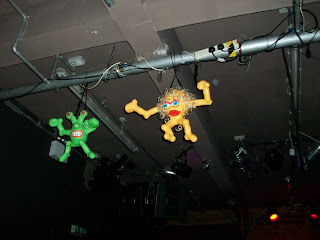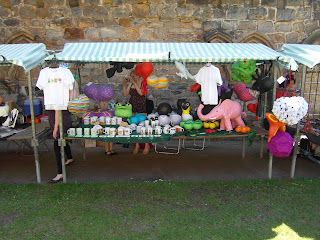After you've decided what you're selling and chosen what to call yourself it's time to decide where you're going to sell it...
Option 1: Selling through a gallery
The
best way to do this is to hang out at the local galleries and get to
know people. It's a massive bonus if you enjoy looking at other peoples
work for hours on end or they have food and drink available and especially if you're sociable and don't mind chatting to strangers.
The last time I did this I found an amazing little gallery which did art classes and sold cheap food (great if you're on a budget). It was even within walking distance from my house. Unfortunately the gallery has since closed down. As has the gallery in Leeds city centre that said if I ever had finished pieces of papier mache furniture to give them a call.
It can be lonely working for yourself and hanging out with
other arty types can be a lot of fun as well as a great source of
support and advice. The main downside is that most galleries charge 20-40% commission although that's often reflected in gallery prices.
My health problems mean that this is no
longer an option for me. As it might not be for you if you are stuck for
time or find the thought of chatting with strangers unappealing. Although I hope you will bear in mind that there are many different types of galleries and many organise groups and classes that might appeal to you and give you an opportunity to check it out.
https://www.culturehealthandwellbeing.org.uk/case-studies-museums-health-and-wellbeing
Option 2: Selling through craft stalls and markets
The best advice I had when it came to craft markets was don't undersell yourself. Of course this advice goes for anyone trying to make money from their own creative work. I now have good intentions of writing another post on pricing your work but, lets just start with finishing this first before I go off on a tangent.
Craft fairs tend to be pretty easy to find online. I found the local council run ones a good place to start, advice was readily available and they were happy to take the time to explain what was needed and how it would work. I don't know how many there are at the moment due to covid restrictions but hopefully we'll be back up and running again soon. But the impact on footfall might make craft stalls a less lucrative venture in the mean time.
It's definitely easier to have a friend around so you can eat and take bathroom breaks, also moral support if the weather turns or it gets quiet and someone to help load and unload the merchandise.
You will need to pay for public liability insurance and the stall - insurance can be quite cheap if you take it out for the year. Most craft fairs provide stalls but some expect you to produce your own. A decorating and pasting table is potentially a cheap but not weatherproof solution to this.
The thing that put me off craft stalls in the end was it cost me more than I made. I was lucky enough to work with my sister and share the costs but too many of my papier mache projects got damaged during transport and there wasn't enough space to wrap everything before transporting them. I know my sister did a lot better than I did by selling printed mugs and t-shirts. Choosing the right market for the products your selling makes a huge difference
Option 3: Selling online
Before choosing a site you'll need to consider is how much time you want to put into advertising your product and generating virtual footfall. I didn't think about this until I started trying to sell on etsy and realised I'd either have to put a lot of time into advertising my own work or pay for etsy to advertise for me. I assume there are sites out there that organise all the SEO stuff and online advertising as part of the cost but I haven't tried enough to work out which. I'll try Instagram next and perhaps one of the sites that charge a monthly fee for renting a virtual shop. As you can see from the picture bellow only a small percentage of people came through etsy searches. Most of the people looking at the shop were my friends being nosy. I also had this problem last time I tried etsy.
For selling online pictures are one of the most important things you'll need. You'll need a decent camera. This is where I'm stuck. I've read so much about pixel depth vs some other acronym I didn't understand, dslr vs mirrorless, 4k vs 1080p and took a break after it came to too much information vs my poor brain. I guess this will make for another blog post where I can share what I learnt from my research. I'm trying hard to keep costs down so looking into second hand ones. I do know 20mp is the minimum requirement and not all cameras are equal.
The sites I read all told me that the description of your work is game changing. People want to hear a story apparently. None of the people I chatted to in person (yes I bore everyone I talk to senseless with this) cared about the description. Most never read past the first few lines but these people also don't tend to buy their arts and craft stuff online. So who knows. I'm still trying to work out where to draw the line between 'it took bloody ages and I am proud I managed not to burn it in the garden one night after getting fed up with the whole thing' and 'a lot of love and passion went into this wonderful piece. I wove my soul into it's creation until I made it sing to me' unfortunately I can no longer drink or I think a few glasses of gin would help me with this one. Reading the descriptions of those that are selling well helps a lot. I found they often mentioned a description of what it is, what it's made from and what influenced their choices or inspired them to make it.
https://www.etsy.com/uk/shop/AnUnladylikeArtisan?ref=seller-platform-mcnav
My shop is still a work in progress. I keep editing it as I learn and spot mistakes. Having a friend proof read everything helps a lot.







